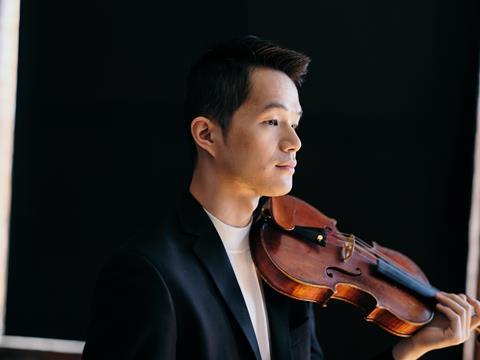Juggling solo repertoire and different instruments amid a busy performance schedule, violinist Lun Li shares a seven-day run up preparing for a solo recital at the Morgan Library and Museum in New York City

Discover more Featured Stories like this in The Strad Playing Hub
As part of his 2023-2024 Young Concert Artists (YCA) season, Lun Li performed as part of a recital series at New York City’s Morgan Library & Museum on 24 April 2024. The solo violin recital featured works of ’perpetual motion’ and incorporated a display by lighting designer Liz Schweitzer to augment the performance experience. Li performed on both the Stradivari ’Samazeuilh’ 1735 violin, and on a Baroque period instrument Maggini c.1600, generously sponsored Cynthia Roberts.
Day 1
As a monstrous solo violin recital programme looms, today was almost entirely dedicated to working with composer Alistair Coleman on his Violin Concerto with the Curtis Symphony Orchestra. With so much on my plate, keeping a sharp and uncluttered mental space felt more crucial than running my fingers up and down the violin. I practised trying to get into a headspace where my listening became so sharp that the air around me felt noisy. Then I spent some time tackling the trickiest parts of works by Bartók, Bach, and Tessa Lark to ensure that I can freely express my intentions on the violin.
Day 2
Today was a free day, and I ambitiously planned to run through the entire programme. And of course it didn’t happen. I started the morning with a gentle warm-up and pitch practice, playing scales and a basic I, IV, V, I chord progression for all the keys in the programme (A, D, and G). Later, I fell into the black hole of slow practice, mostly for Bartók. Spend long enough with a piece, your listening becomes so sensitive that it registers every tiny impurity in pitch or sound. I’m not sure if that’s a great thing. The slow practice drained my energy, and I gave up on running through the entire programme, opting instead to practise the new concerto I was premiering the next day.
Day 3
Concert day! It served as a good cooldown for all the prep work I’d done over the past few months. I tried not to think about the solo programme for even a split second. But of course, as soon as I finished the concert, I rushed back to the practice room to see if I could still play some of the recital pieces. As if that 20 minutes would change a thing… oh well.
Day 4
I got home to New York in the morning. With limited practice time on the Baroque violin before, I spent a significant amount of time getting used to playing on gut strings and without accessories like the chin rest and shoulder rest on my second violin. Determined to run through the programme for my graduation recital the next day, I found a quiet space and recorded the run to make myself nervous. In the end, I didn’t listen to it because, during the run, I felt like I achieved a third-person perspective and trusted my hearing.
Day 5
The Baroque violin I’ll use for the Morgan Library recital finally became available today. About two hours before my graduation recital, the violin’s owner, Cynthia Roberts, returned from her three-week concert tour. I quickly ran through some shorter pieces on the programme to get used to the instrument’s mechanics. My graduation recital felt great; it was recorded, so I went back and listened to it, making notes for the next two days.
Day 6
This morning started with a lesson from my dear teacher Catherine Cho. The lesson gave me a significant mental boost before the concert. I asked if she’d like to hear me run through the programme again after yesterday, and she kindly sat through another hour of mostly perpetual motion music. In retrospect, this might not have been the best idea as my shoulder started giving me problems afterward. I took the rest of the day easy, playing slowly through spots where I didn’t feel completely free.
Day 7
Today was dress rehearsal day. I took the morning very slowly, playing gently and quietly. I did some intense mental practice, singing the melody and switching up mental cues like images, shapes, languages, and scents to create a little theatre in my head that’s connected to the music. During the dress rehearsal, I adjusted my playing to the space and spent hours experimenting with the logistics of lighting, positioning, and transitions. It makes a huge difference when you have complete confidence and artistic authority over every aspect of the concert.
Concert Day
I like to avoid having a specific ritual on concert day. After all, it’s just a concert.
Read: Violinist Bella Hristova: how do you get to Carnegie Hall?
Read: The road to Wigmore: cellist Sterling Elliott’s practice diary
Read more Featured Stories like this in The Strad Playing Hub
The number one source for playing and teaching books, guides, CDs, calendars and back issues of the magazine.
In The Best of Technique you’ll discover the top playing tips of the world’s leading string players and teachers. It’s packed full of exercises for students, plus examples from the standard repertoire to show you how to integrate the technique into your playing.
The Strad’s Masterclass series brings together the finest string players with some of the greatest string works ever written. Always one of our most popular sections, Masterclass has been an invaluable aid to aspiring soloists, chamber musicians and string teachers since the 1990s.
American collector David L. Fulton amassed one of the 20th century’s finest collections of stringed instruments. This year’s calendar pays tribute to some of these priceless treasures, including Yehudi Menuhin’s celebrated ‘Lord Wilton’ Guarneri, the Carlo Bergonzi once played by Fritz Kreisler, and four instruments by Antonio Stradivari.






































No comments yet